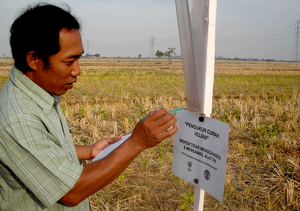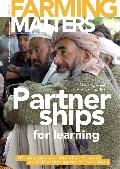Agro-meteorological learning in Indonesia.
Unusual wheather patterns helped farmers see the relationship between rainfall quantities, soil moisture and the growth of their crops. Photos: Yunita Winarto

Local knowledge systems are always developing, especially in times of change. The meteorological effects of El Niño, and climate change in general, motivated farmers and researchers in Indonesia to set up a close learning partnership. Working together, and observing the rains in detail, provided new information which helped the farmers adapt their agricultural strategies.
Farmers are known to be good observers of their own fields and habitats. Their ways of knowing and the body of local knowledge is called ilmu titèn in Indonesian (roughly translated as “carrying detailed observations and memorable results”). But changing weather patterns mean that traditional indicators no longer help farmers decide when to start planting. This was one of the major issues discussed by the farmers who participated in a Climate Field School in Gunungkidul, near Yogyakarta. They all agreed that climate change is having a serious influence on their daily lives.
Two way learning in Gunungkidul
In November 2008 a group of researchers and students in anthropology and other disciplines of the Gadjah Mada University, Yogyakarta, visited Gunungkidul as part of their ethnographic fieldwork. They recommended that those who had taken part in the Climate Field School should further develop their observations, to try to better understand the changes they were experiencing. As the farmers had no reliable way to measure rainfall, ten rain gauges with calibrated scales were purchased and distributed among them. The researchers assisted the farmers in choosing locations for the gauges, in setting them up, in using them to measure rainfall and in deciding what to observe in their fields. They helped farmers keep track of their measurements and observations.
Farmers became enthusiastic when they were able to relate rainfall to the amount of water trapped in the rain gauge. They were also able to directly see the relationship between these numbers, soil moisture and the growth of their crops. Gradually, their local taxonomy of rain, expressed in words, was enriched by quantifying each category, while the researchers’ quantitative approach was enriched by the local expressions of the characteristics and the impacts of the rains (Table 1).
| No. | Categories of rain in local term | Rain characteristics | Impacts on soil | Equivalent in numbers |
| 1 | Udan kremun | Small rain, very soft, short duration |
No trails on the soil | (0 mm) |
| 2 | Udan thletik | Fast small rain, lasts only a minute | No trails on the soil | (0 mm) |
| 3 | Udan gerimis | No sound of the rain, can be felt by hands, long duration | No trails with a short duration of rain, drops on the crops with a long duration | 0.5—5 mm |
| 4 | Udan tretak-tretik | Small rain with “thik-thik” sound on the roof. a.short duration b.long duration |
Some trails: the soil becomes wet in both the short and the long duration of rain, no standing water. | a.1—3 mm. b.3—5 mm. |
| 5 | Udan pral-pril | Small rain in April, not daily, in short or long duration. Sound on the roof. | Similar trails to no. 4 (soil becomes wet, but no standing water) | 1—5 mm or 5—10 mm. |
| 6 | Udan ora deres nanging kerep (not heavy but frequent and intense) |
Not heavy, but noisy on the roof with long duration of rain. Another term: “udané awèt” (persisting rain) |
“Red-soil” becomes very wet, some water standing The soil becomes very wet, sticky, and compresses when people step on iton “heavy-black soil” |
<30 mm. |
| 7 | Udan deres bres | Heavy rain, very noisy on the roof, but usually not persistent in a long duration of rain |
The soil becomes very wet, sticky, and compresses when people step on it | >30 mm. |
| 8 | Udan bar-ber (very heavy rain) and banjir in very heavy intense rain which floods |
Heavy rains between September and December; high frequency and intensity, long duration | If the rain lasts for one day, there will be standing water, especially on heavy black soil. In the absence of drainage, the fields become flooded | >70 mm. (in 2008/09, up to >100 mm) |
Researchers also found out that, while farmers frequently go to the field throughout the planting season, it was something completely different for them to go every morning to the field at a particular time and take notes of what they measured and observed. Not all of them were happy to commit to such a regime without any compensation for their time or for the petrol they needed for using motorbikes.
Bringing notes and pens to the fields in order to take notes there was also a new practice. Some farmers relied on their memories and did the writing at home. The researchers tried to develop data-sheets to help farmers write down their findings in a simple way. These sheets went through several revisions and improvements, in response to the farmers’ comments. So both parties learned from the process: this was also the first time the anthropologists tried to process rainfall data into a graphic form, and to develop agroecological observations into stories and matrices that could subsequently be interpreted by the agrometeorologist.
More than measuring
The agrometeorologist visited the site regularly. Site meetings with him were used to present, explain and discuss the graphics of rainfall distribution at the points of observation, and their relation with the agrometeorological data collected by farmers. Farmers were also able to use these meetings as an opportunity to raise questions about what was happening at the moment.
In 2009 the rains lasted well into June, the normal dry season, which is a very unusual phenomenon. Several crops, such as tobacco, chilli, and a newly introduced bean called koro, were severely damaged. While this caused the farmers problems, it also allowed them to increase their understanding of unexpected weather conditions by comparing the total quantities of rainfall, the impact on their fields, while also referring to their traditional knowledge. Farmers said that this experience, and the knowledge it gave them, meant that they were now better able to anticipate similar future weather conditions and prepare themselves for them.
Sadly, this knowledge did not always lead to action. Heavy rains and a lack of water for long periods were identified as the situations that farmers were most vulnerable to: few farmers in this area have drainage or water reservoirs. But despite many discussions, the suggestion to collectively build drainage and storage ponds was not followed. Such investments would have involved setting up a higher-level organisation, covering large areas of fields which criss-crossed existing administrative boundaries. Without any support from local authorities, the farmers felt incapable of carrying out such measures.
Complex learning in Indramayu
Based on the experience in Gunungkidul, the anthropologists approached a group of farmers in Indramayu, in West Java, an area where the first Climate Field Schools were tried in 2003. The establishment of a network of 50 points-of-observation, representing diverse ecosystems within the Indramayu regency, marked the beginning of a collaborative programme involving anthropologists, agrometeorologists, students from Universitas Indonesia and farmers. Due to the larger size and scope of the project the farmers developed a more complex organisation, dividing their regency into three zones, with co-ordinators in each zone responsible for monitoring a number of points-of-observation.
The project was intended to last for three years but, due to a series of internal conflicts and difficulties in finding funds, the official collaborative research was terminated after only four months. However, in that short period, the farmers learned much from the severe drought that delayed their planting season. They tried out a number of strategies, including switching from wet-nursery to dry-nursery seedbeds, selecting rice varieties with a shorter growing period, and building groundwater ponds, all of which proved to be beneficial. Although the official collaboration with the farmers’ organisation could not go on as hoped, some farmers continued their own individual observations. They decided to form “the club of rainfall observers” and continued their own measurements with locally constructed cylindrical rain gauges. They asked researchers to continue supporting them.
Lessons learned
The cases described here show some of the difficulties involved in collaborative learning between farmers and researchers. Farmers are not always overly concerned about using standardised procedures for measurements, or being very precise in gathering reliable and standardised data. They perceive learning programmes as “projects” and expect money to compensate them for their time and efforts. At the same time, local norms, values and cultural hierarchies can also be a hindrance in the negotiations between scholars and farmers. Local elites and leaders can have ideas, perspectives and interests that are not in line with the scholars’ objectives. Yet the benefits of working together can outweigh these difficulties, and these are even greater if:
- scholars do not micro-manage the way that farmers make observations. After giving a few basic instructions and suggestions for data taking, the organisation of data collection can be left to the farmers’ own initiative;
- proximity and trust is built in throughout the learning process;
- sufficient time is taken to explain the background of climate change and its consequences, in terms that everybody can understand and to allow farmers time to ask questions and have them answered;
- a regular exchange of practical information between farmers and researchers takes place, helping farmers address their vulnerabilities and to find adaptation strategies to climate change.
Text: Yunita T. Winarto, Kees Stigter, Esti Anantasari, Hestu Prahara and Kristyanto
Yunita T. Winarto Professor in Anthropology and Academy Professor in Social Sciences and Humanities (Universitas Indonesia), can be contacted at yunita.winarto@gmail. com. Kees Stigter (cjstigter@usa.net) is Visiting Professor, Agromet Vision, Bondowoso. Esti Anantasari is graduate student at the Gadjah Mada University; Hestu Prahara and Kristyanto are research assistants at Universitas Indonesia.

